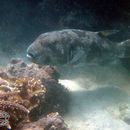Diagnostic Description
provided by Fishbase
Body covered with prickles (Ref. 559). Juveniles with dark stripes on belly, becoming spots with growth; adults with or without spots on fin (Ref. 4919).Description: Characterized further by pale grey body color with dense covering of black spots on head, body and fins; large black spots or irregular blotches around bases of pectoral and dorsal fins; head and body with small spinules except top of snout, base of fins and side of caudal peduncle, best developed spinules on ventral surface; short snout, length about 1.7-2.7 in head length; bony interorbital width 2.2-2.4 in head length; rounded caudal fin, length 4.0-5.0 in SL (Ref. 90102).
- Recorder
- Cristina V. Garilao
Life Cycle
provided by Fishbase
Oviparous (Ref. 205).
Morphology
provided by Fishbase
Dorsal spines (total): 0; Dorsal soft rays (total): 10 - 12; Analspines: 0; Analsoft rays: 10 - 11
- Recorder
- Cristina V. Garilao
Trophic Strategy
provided by Fishbase
Relatively uncommon in patch reefs and coral slopes near sandy areas of clear lagoon and seaward reefs. Juveniles occur in sandy and weedy inner reefs, adults on clear lagoons and seaward reefs (Ref. 9710). Enter estuaries (Ref. 4833).
- Recorder
- Grace Tolentino Pablico
Biology
provided by Fishbase
Relatively uncommon in patch reefs and coral slopes near sandy areas of clear lagoon and seaward reefs. Juveniles occur in sandy and weedy inner reefs, adults on clear lagoons and seaward reefs (Ref. 9710). Juveniles inshore, usually on muddy substrates and often estuarine. Adults on deep slopes and range to outer reefs, sometimes swimming high above the substrate or just below the surface. Pelagic larvae may disperse over great distance and juveniles occur in subtropical zone (Ref. 48637). Enter estuaries (Ref. 4833). Considered as the giant among puffers reaching a total length well in excess of a meter.
- Recorder
- Estelita Emily Capuli
Importance
provided by Fishbase
fisheries: of no interest
- Recorder
- Estelita Emily Capuli

